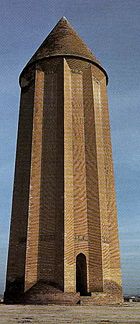Ciyarids
The Ziyariden (Germanized also Sijariden ; Persian آل زیار, DMG Āl-e Ziyār ) were a local Iranian dynasty, which ruled over the northern Iranian regions Tabaristan and Gurgan (the area of today's provinces Mazandaran and Golestan ) from approx. 931 to 1090 . The main cities were Astarabad and Amol .
The founder of the Muslim dynasty was Abu l-Hajjaj Mardawidsch ibn Ziyar (ruled approx. 931-935). The noble commander of Gilan took advantage of the disintegration of the Abbasid - Caliphate and the rebellion of a Samanid from general to on the south coast of the Caspian Sea to create a separate rule. For a short time he even controlled an extensive territory, which included Hamadan and Isfahan , among others , but he was finally murdered by his Mamluk troops, which overflowed to the Buyids , so that the power of the Ziyarids was again limited to Tabaristan.
After the principality was then consolidated under Zahir ad-Daula Abu Mansur Wuschmgir ibn Ziyar (r. 935-967), it reached its political and cultural level under Shams al-Maali Abu l-Hasan Qabus ibn Wuschmgir (r. 978-1012) highlight: Qabus promoted art and science , but at times the cast had to accept the country by the Buyids (981-97) and later the supremacy of the Ghaznavids recognize. Falak al-Maali Manutschihr ibn Qabus (r. 1012-1029) was even the son-in-law of Sultan Mahmud of Ghazna . Since the trade routes between Iraq , Khorasan and Transoxania were also controlled with Tabaristan , the principality was able to achieve considerable economic prosperity.
From 1041 the Ziyarids had to recognize the suzerainty of the Turkish Seljuks until they were overthrown by the assassins invading Tabaristan around 1090 . Until the conquest by the Mongolian Ilkhan , Tabaristan became a center of the Ismailite sect.
The penultimate Ziyarid prince Unsur al-Maali Kai-Kawus ibn Iskandar ibn Qabus (ruled approx. 1049-1087), who also married a daughter of Mahmud of Ghazna, lived with Sultan Maudud ibn Masud for eight years and traveled extensively (including to the Shaddadids according to Arran ), gained fame as the author of a Persian prince mirror with the title Qabus-nama , which he dedicated to his son Gilan-Shah (approx. 1087-1090).
List of rulers and family tree
- Abu al- Hajajj Mardawidsch b. Ziyar, 931-935
- Zahir ad-Daula Abu Mansur Voshmgir b. Ziyar, 935-967
- Zahir ad-Daula Abu Mansur Bisutun b. Voshmgir, 967-978
- Shams al-Maali Abu l-Hasan Qaboos b. Voshmgir (= Qābūs ibn Wušmagīr ), 977 / 978-981 and 987-1012 / 1013
- Falak al-Maali Manutschehr b. Qaboos, 1012-1029
- Abu Kalidjar Anushirawan b. Manutschehr, approx. 1029-1049
- Onsor al-Maali Kejkawus b. Iskandar b. Qaboos, approx. 1049-1087
- Gilan Shah b. Kejkawus, approx. 1087-1090
| Vardanschah | |||||||||||||||||||||||||||||||||||||
| Ziyar | |||||||||||||||||||||||||||||||||||||
|
Mardawidsch 931-935 |
Voshmgir 935-967 |
||||||||||||||||||||||||||||||||||||
| Farhad |
Bisutun 967-978 |
Qaboos 977-981 & 987-1013 |
Salar | Langar | |||||||||||||||||||||||||||||||||
|
Manutschehr 1012-1029 |
Dara | Iskandar | |||||||||||||||||||||||||||||||||||
|
Anuschirawan 1029-1049 |
Kejkawus 1049-1087 |
||||||||||||||||||||||||||||||||||||
|
Gilan Shah 1087-1090 |
|||||||||||||||||||||||||||||||||||||
Literature and web links
- CE Bosworth : "On the Chronology of the Ziyārids in Gurgān and Ṭabaristān" in Der Islam 40, 1964, pp. 25-34.
- CE Bosworth: "ZIYARIDS" (2010) in Encyclopædia Iranica
- W. Madelung: "The Minor Dynasties of Northern Iran" in The Cambridge History of Iran IV, pp. 198–249 (Google Book Preview)
- GC Miles: "The Coinage of the Ziyārid Dynasty in Gurgan and Tabaristan" in ANS Museum Notes 18, 1972, pp. 119-137.

